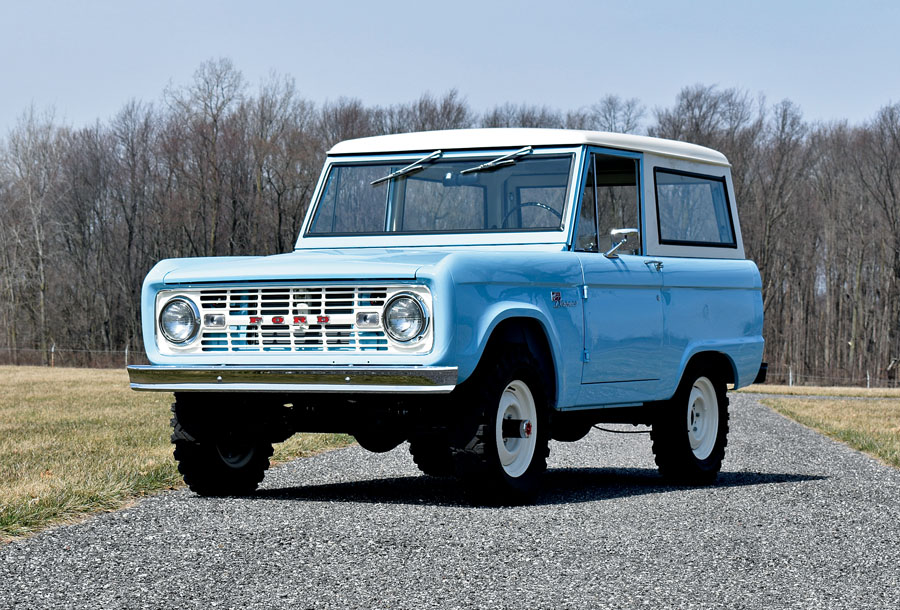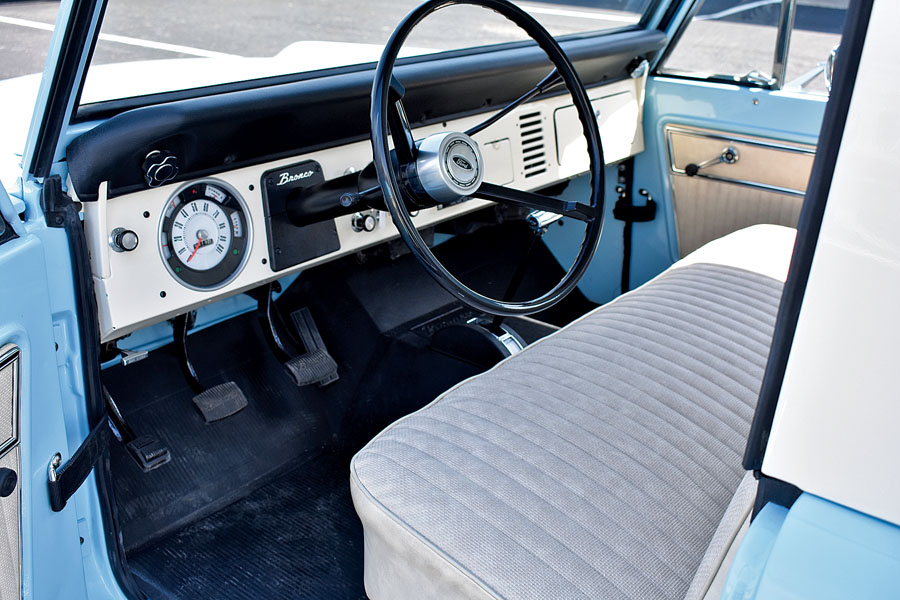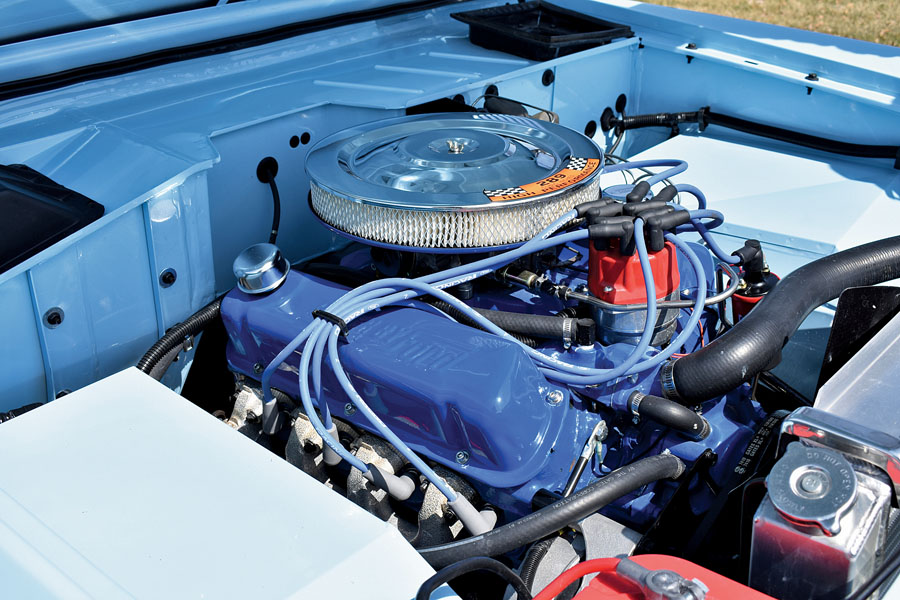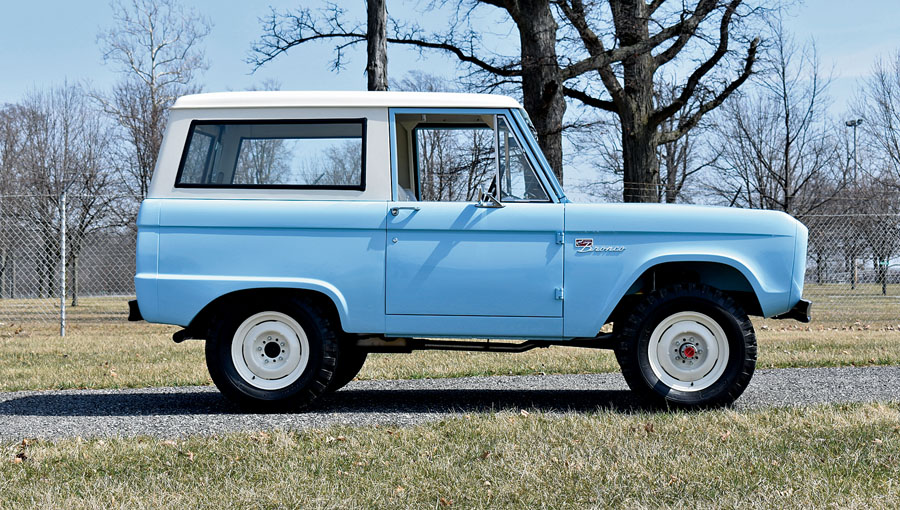- 289-ci V8 engine with mild cam
- Column-shift manual transmission with four-wheel drive
- Professional body-off restoration
- Correct paint and interior per Marti Report
- Ceramic-coated exhaust manifolds
SCM Analysis
Detailing
| Vehicle: | 1968 Ford Bronco |
| Years Produced: | 1966–77 |
| Number Produced: | 23,776 in 1966; 225,585 total from 1966 to 1977 |
| Original List Price: | $2,194 |
| SCM Valuation: | $33,000 |
| Chassis Number Location: | On glovebox door and on passenger’s side frame rail forward of the footwell body mount |
| Club Info: | Bronco HQ, Classic Broncos Forums |
| Website: | http://www.broncohq.com |
| Alternatives: | 1954–83 Jeep CJ-5, 1961–1980 International Harvester Scout, 1960–77 Toyota FJ40 |
| Investment Grade: | B for now, but may drop to C if the vintage-SUV market tanks |
This truck, Lot 3108, sold for $42,900, including buyer’s premium, at the RM Auctions sale in Auburn, IN, on May 12, 2018.
The Ford Bronco was introduced in August of 1965 (the 1966 model) to play catch-up with the sales success of the Jeep CJ-5 and the International Harvester Scout.
Much like the Jeeps and Scouts, the early Broncos were basic utilitarian machines: no frills and with very few options. This kept the price point down, so Ford could build them cheaply and sell them for less than $2,200.
The early models came standard with a 170-ci, 105-horsepower inline 6 mated to a 3-speed column-shift transmission. The interiors were gloriously simple. A basic single instrument housed the speedometer and all your vital information within it. No carpet was installed. You could have probably made the seats in your own garage, and the door panels were sparse and simple.
This was long before Ford trucks became comfortable highway cruisers and family vehicles.
Still, these simple trucks had four-wheel drive. They were lock-your-own-hubs trail beaters that you could take off road and enjoy with little worry for the paint.
These were great hill climbers. With the proper lift and set of oversized all-terrain tires, they could traverse muddy ditches, creeks and uneven terrain with sure-footed success.
On the downside, a lifted Bronco with bouncy, Tonka Toy tires was terribly unpredictable on the highway at anything over 55 mph (don’t ask me how I know this). At speed, in a modified example, turning the steering wheel was a suggestion for the direction of travel.
The Bronco sold well and came in three configurations — the Wagon, Half Cab and Roadster. Ford sold 23,776 units in 1966.
Shortly after the early models hit the trails, Ford upped the engine option to add the spunky 289-ci V8. This powerful engine gave the Bronco the ability to toss soupy cow patties into any following Jeeps.
The first-generation body style ran pretty much unchanged from 1966 to 1977, with total production ramping up to a plentiful 212,707 units sold.
Climbing the value hill
The market for just about any sort of vintage truck or SUV heated up a while back, and it just keeps getting hotter.
The vintage-truck trend seems to be firing up all the way to the early 1980s for the right vehicle.
Naturally, the best value can be found in the earlier stuff, such as our subject truck. We’ve witnessed the valuation run for all sorts of vintage utility vehicles such as Toyota FJ40s, Broncos, Blazers, Jeeps and Scouts. Of course, beaters aren’t rising on this tide, but even good-to-great drivers seem to be doing well.
The rugged, no-frills nature of many of these vehicles is part of the allure. These early SUVs are very easy to work on, repair and modify. Parts suppliers and off-road specialty companies are geared up to up-fit your Bronco or Jeep with all sorts of goodies.
Better yet, you can do a lot of upgrades without degrading the value — if you don’t cut or modify the body. In some cases, the right modifications can pull more money on the auction block than a bare-bones, all-stock, minty-fresh example.
In fact, Barrett-Jackson sold a 1969 Bronco that was highly modified into a military-style apocalyptic road warrior named “Urban Madness” for a staggering $143,000 in Scottsdale.
Yep, I want one
I’d love to park a vintage Bronco in my stable. Every time I see one in a parking lot or on the road, they turn my head.
If they are modified — with rolled up canvas side-curtains, a pinned, whipped CD antenna, a jerrycan out back and a winch up front — they are even cooler to me. Now, one guy’s opinion doesn’t make a market, but my philosophy has always been (as a thoroughbred-car nut) that if I want one, so do a few thousand other gearheads.
That valuation system works out for me most of the time.
However, that statement carries an asterisk. Supply and demand always kicks in, and there aren’t enough Broncos for sale to feed the demand of willing buyers. When demand is greater than supply, rising values are the result.
A modified 1968 Bronco sold at Barrett-Jackson’s 2018 Scottsdale sale for $82,500. Mecum sold one for even more — $110,000 — at their Kissimmee sale.
Millennials with money
New, younger buyers wading into the market are fueling the demand curve for vintage trucks and SUVs. Younger buyers are more attracted to vintage utilitarian vehicles than they are old-school muscle cars.
All this means Uncle Charlie might be bidding on the same Bronco as his nephew — which could be sort of awkward. Next thing you know, there’s a family bidding war on the floor.
Ford is placing a few bets on this demand dynamic, with a planned launch of an all-new Ford Bronco that is expected to hit showrooms and trails in 2020. Will that change the market value for vintage models? No one knows.
The first-generation Bronco market
The SCM Platinum Auction Database shows that 1966–77 Broncos sold in the low-to-upper-$30k range in 2016 and 2017. Unfortunately, the Platinum database doesn’t have a lot of Bronco sales results for 2018 (hint). But that didn’t stop me from doing some additional research on my own.
I tossed out all the radically modified examples to keep my research as close as possible to our stock subject truck. This brought us into a selling range, including buyer’s premiums, from the mid-$30k range to upper-$40k ranges. These sales are of nicely restored examples. Most of these Broncos did include some modest modifications. None were concours-correct — simply because they don’t need to be.
Our subject Bronco is in very nice condition. It wasn’t a perfect example, but the restoration was fresh. It had been driven fewer than 20 miles since the restoration was completed.
I’d call our Bronco a 90%-done example, based on a few items that were not restored or just haphazardly put in place. No harm done here, as it would be fun to tinker with this Bronco over time.
RM Auctions ran the Bronco over the block with an estimated sales range of $40,000 to $50,000. This was fair, given the overall presentation and condition.
With the rising tide of recent vintage Bronco sales coupled with the overall current appeal of the SUV and truck market in general, I’d call this a market-correct result for a quality restoration. ♦
(Introductory description courtesy of RM Auctions.)



